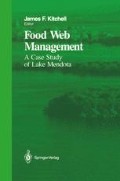Abstract
Freshwater plankton communities are regulated by a variety of factors, among which nutrients and predators are two of the most important. Increases in limiting nutrients such as phosphorus and nitrogen can stimulate production and biomass of phytoplankton (Schindler 1978), which in turn can stimulate production and biomass of herbivorous zooplankton. Predators such as fish can influence plankton communities through selective predation on large zooplankton species (Zaret 1980; Northcote 1988). Because large zooplankton species have relatively high grazing rates (per individual) on phytoplankton and graze on a wider range of food particles (Burns 1969), size-selective predation on large zooplankton can also have a substantial influence on phytoplankton (Carpenter and Kitchell 1988; Vanni et al. 1990a).
Access this chapter
Tax calculation will be finalised at checkout
Purchases are for personal use only
Preview
Unable to display preview. Download preview PDF.
References
Benndorf J, Schultz H, Benndorf A, Unger R, Penz E, Kneschke H, Kossatz K, Dumke R, Hornig U, Kruspe R, Reichel R (1988) Food-web manipulation by enhancement of piscivorous fish stocks: Long-term effects in the Bautzen reservoir. Limnologica 19:97–110
Brock TD (1985) A Eutrophic lake: Lake Mendota, Wisconsin. Springer-Verlag, New York
Burns CW (1969) The relationship between body size of filter-feeding Cladocera and the maximum size of particle ingested. Limnol. Oceanogr. 13:675–678
Carpenter SR, Kitchell JF (1984) Plankton community structure and limnetic primary production. Am. Nat. 124:159–172
Carpenter SR, Kitchell JF (1987) The temporal scale of variance in limnetic primary production. Am. Nat. 129:417–433
Carpenter SR, Kitchell JF (1988) Consumer control of lake productivity. BioScience 35:634–639
Gliwicz ZM, Lampert W (1990) Food thresholds in Daphnia species in the absence and presence of blue-green filaments. Ecology 71:691–702
Goldman JC, McCarthy JJ, Peavey DG (1979) Growth rate influence on the chemical composition of phytoplankton in oceanic waters. Nature 279:210–215
Lathrop RC (1990) Response of Lake Mendota (Wisconsin, USA) to decreased phosphorus loadings and the effect on downstream lakes. Verh. Internal. Ver. Theoret. Angew. Limnol. 24:457–463
Lehman JT (1980) Nutrient recycling as an interface between algae and grazers in freshwater communities. In Kerfoot WC (ed) Evolution and ecology of freshwater zooplankton communities, University Press of New England, Hanover, New Hampshire, pp 251–263
Luecke C, Vanni MJ, Magnuson JJ, Kitchell JF, Jacobson PT (1990) Seasonal regulation of Daphnia populations by planktivorous fish: Implications for the spring clear-water phase. Limnol. Oceanogr. 35:1718–1733
Muck P, Lampert W (1984) An experimental study on the importance of food conditions for the relative abundance of calanoid copepods and cladocerans. Arch. Hydrobiol. (Suppl. 66) 2: 157–179
Northcote TG (1988) Fish in the structure and function of freshwater ecosystems: A “top-down” view. Can. J. Fish. Aquat. Sci. 45:361–379
Peters RH, Downing JA (1984) Empirical analysis of zooplankton filtering and feeding rates. Limnol. Oceanogr. 29:763–784
Porter KG, Gerritsen J, Orcutt JD (1982) The effect of food concentration on swimming patterns, feeding behavior, ingestion, assimilation, and respiration by Daphnia. Limnol. Oceanogr. 27:935–949
Reynolds CS (1984) The ecology of freshwater phytoplankton. Cambridge University Press, Cambridge
Scavia D, Lang GA, Kitchell JF (1988) Dynamics of Lake Michigan plankton: A model evaluation of nutrient loading, competition, and predation. Can. J. Fish. Aquat. Sci. 45:165–177
Schindler DW (1978) Factors regulating phytoplankton production and standing crop in the world’s lakes. Limnol. Oceanogr. 23:478–486
Stauffer RE (1987) Vertical nutrient transport and its effects on epilimnetic phosphorus in four calcareous lakes. Hydrobiologia 154:87–102
Vanderploeg HA, Scavia D (1979) Calculation and use of selectivity coefficients of zooplankton grazing. Ecol Model. 7:135–149
Vanderploeg HA, Scavia D, Liebig JR (1984) Feeding rate of Diaptomus sicilis and its relation to selectivity and effective food concentration in algal mixtures and in Lake Michigan. J. Plankton Res. 6:919–941
Vanni MJ, Luecke C, Kitchell JF, Allen Y, Temte J, Magnuson JJ (1990a) Effects on lower trophic levels of massive fish mortality. Nature 344:333–335
Vanni MJ, Luecke C, Kitchell JF, Magnuson JJ (1990b) Effects of planktivorous fish mass mortality on the plankton community of Lake Mendota, Wisconsin: Implications for biomanipulation. Hydrobiologia 200/201:329–336
Vanni MJ, Temte J (1990) Seasonal patterns of grazing and nutrient limitation of phytoplankton in a eutrophic lake. Limnol. Oceanogr. 35:697–709
Zaret TM (1980) Predation and freshwater communities. Yale University Press, New Haven, Connecticut.
Editor information
Editors and Affiliations
Rights and permissions
Copyright information
© 1992 Springer-Verlag New York Inc.
About this chapter
Cite this chapter
Vanni, M.J., Carpenter, S.R., Luecke, C. (1992). A Simulation Model of the Interactions Among Nutrients, Phytoplankton, and Zooplankton in Lake Mendota. In: Kitchell, J.F. (eds) Food Web Management. Springer Series on Environmental Management. Springer, New York, NY. https://doi.org/10.1007/978-1-4612-4410-3_21
Download citation
DOI: https://doi.org/10.1007/978-1-4612-4410-3_21
Publisher Name: Springer, New York, NY
Print ISBN: 978-1-4612-8760-5
Online ISBN: 978-1-4612-4410-3
eBook Packages: Springer Book Archive

